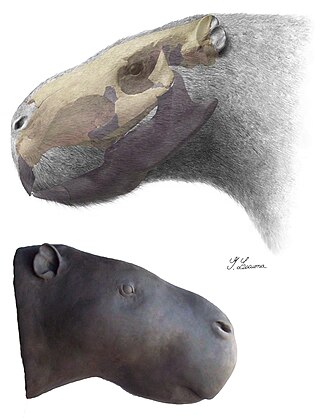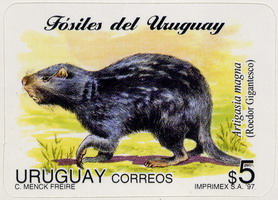Josephoartigasia magna Francis and Mones, 1966

(Da: en.wikipedia.org)
Phylum: Chordata Haeckel, 1874
Subphylum: Vertebrata Cuvier, 1812
Classe: Mammalia Linnaeus, 1758
Ordine: Rodentia Bowdich, 1821
Famiglia: Dinomyidae Peters, 1873
Genere: Josephoartigasia Mones, 2007
Descrizione
Specie gigante di roditore del Pliocene. La specie fu descritta da j:c: Francis e A. Mones e fu ascrutta al genere Artigasia. In recenti studi (2007) A. Mones lo ha attribuito al genere Josephoartigasia.
Diffusione
I resti fossili sono stati trovati nella Formazione San Jose, Playa Kiku, Chapadmalalan e Uruguay.
Bibliografia
–Rinderknecht, A.; Blanco, R. E. (January 2008). "The largest fossil rodent". Proceedings of the Royal Society B. 275 (1637): 923-928.
–Francis, J. C.; Mones, A. (1966). "Artigasia magna n. g., n. sp. (Eumegamyinae), un roedor gigantesco de la época Pliocena Superior de las Barrancas de San Gregorio, Departamento de San José, República Oriental del Uruguay" [Artigasia magna n. g., n. sp. (Eumegamyinae), a giant rodent from the Upper Pliocene epoch from the St Gregorio Hills, Department of San José, Eastern Republic of Uruguay]. Kraglieviana (in Spanish) (3): 89-100.
–Mores, A. (2007). "Josephoartigasia, nuevo nombre para Artigasia Francis & Mones, 1996 (Rodentia, Dinomyidae), non Artigasia Christie, 1934 (Nematoda, Thelastomatidae)" [Josephoartigasia, new name for Artigasia Francis & Mones, 1996 (Rodentia, Dinomyidae), non Artigasia Christie, 1934 (Nematoda, Thelastomatidae)] (PDF). Comunicaciones Paleontologicas Museo Nacional de Historia Natural y Antropologia (in Spanish). 2 (26): 213-14.
–
–Hernandez, M. (17 January 2008). "Long Ago, a Rodent as Big as a Bull Lurked in South America". The New York Times.
–Rinderknecht, A.; Enrique, B. T.; Ubilla, M. (2011). "New genus of giant Dinomyidae (Rodentia: Hystricognathi: Caviomorpha) from the late Miocene of Uruguay". Journal of Mammalogy. 92 (1): 170, 176.
–Francis, J. C.; Mones, A. (1965). "Contribución a la Geología y Paleontología de las Barrancas de San Gregorio, Departamento de San José, República Oriental del Uruguay" [Contribution to the geology and paleontology of the San Gregorio Hills, San José Department, Oriental Republic of Uruguay]. Kraglieviana (in Spanish). 1 (2): 55-85.
–Bossi, J.; Ortiz, A.; Perea, D. (2009). "Pliocene to middle Pleistocene in Uruguay: A model of climate evolution". Quaternary International. 210 (1-2): 37-43.
–Goso, H.; Bossi, J. (1966). "Cenozoico". In Bossi, J. (ed.). Geología del Uruguay [Geology of Uruguay] (in Spanish). Universidad de la República, Montevideo. pp. 259-301.
–Mones, A. (1988). "Notas paleontológicas uruguayas. IV. Nuevos registros de mamíferos fósiles de la Formación San José (Plioceno–Plesitoceno inferior?) (Mammalia: Xenarthra; Artiodactyla; Rodentia)". Comunicaciones Paleontologicas Museo Nacional de Historia Natural de Montevideo. 20: 255-277.
–Mcdonald, H. G.; Perea, D. (2002). "The large scelidothere Catonyx tarijensis (Xenarthra, Mylodontidae) from the Pleistocene of Uruguay". Journal of Vertebrate Paleontology. 22 (3): 677-683.
–Blanco, R. E.; Rinderknecht, A.; Lecuona, G. (2012). "The bite force of the largest fossil rodent (Hystricognathi, Caviomorpha, Dinomyidae): Largest rodent bite force". Lethaia. 45 (2): 157-163.
–Bene, S.; Nagy, B.; Kiss, B.; Polgár, J. P.; Szabó, F. (2007). "Comparison of body measurements of beef cows of different breeds". Archives Animal Breeding. 50 (4): 363-373.
–Millien, Virginie (May 2008). "The largest among the smallest: the body mass of the giant rodent Josephoartigasia monesi". Proceedings of the Royal Society B. 275 (1646): 1953-5, discussion 1957-8.
–Blanco, R. Ernesto (7 September 2008). "The uncertainties of the largest fossil rodent". Proceedings of the Royal Society B: Biological Sciences. 275 (1646): 1957-1958.
–Engelman, Russell K. (June 2022). "Resizing the largest known extinct rodents (Caviomorpha: Dinomyidae, Neoepiblemidae) using occipital condyle width". Royal Society Open Science. 9 (6): 220370.
–Cox, Philip G.; Rinderknecht, Andrés; Blanco, R. Ernesto (2015). "Predicting bite force and cranial biomechanics in the largest fossil rodent using finite element analysis". Journal of Anatomy. 226 (3): 215-23.
–Midgley, J. J.; Gallaher, G.; Kruger, L. M. (2012). "The role of the elephant (Loxodonta africana) and the tree squirrel (Paraxerus cepapi) in marula (Sclerocarya birrea) seed predation, dispersal and germination". Journal of Tropical Ecology. 28 (2): 230.

|
Data: 05/05/1997
Emissione: Animali preistorici Stato: Uruguay |
|---|